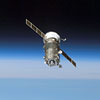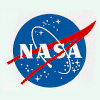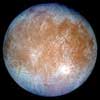|
Sunday:
September 7, 2003 | |
0418 GMT |
 |
'Cannonball pulsar' seen flying across space
Astronomers have captured an image of a pulsar flying through space at 20 times the speed of sound, with radiant twin tails of X-ray light stretching nearly two billion miles from this tiny, dense sphere only about 12 miles across.
 FULL STORY FULL STORY
 |  |

|
 |
NASA opens new chapter in supersonic flight
Flight tests completed by NASA, with government and industry partners, may have demonstrated a way to reduce the window-rattling impact of sonic booms.
 FULL STORY FULL STORY
 |  |

|
 |
|
Saturday:
September 6, 2003 | |
0424 GMT |
 |
Plasma found at black hole
Astronomers report they have detected remarkably stormy conditions in the hot plasma being pulled into the monstrous black hole residing at the center of our Milky Way galaxy, 26,000 light years away.
 FULL STORY FULL STORY
 |  |

|
 |
Hubble assists Europe's Rosetta comet mission
Results from the Hubble Space Telescope played a major role in preparing ESA's ambitious Rosetta mission for its new target, comet 67P/Churyumov-Gerasimenko. Hubble has been the critical tool in measuring precisely the size, shape and rotational period of the comet. Information that is essential if Rosetta is to rendezvous with a comet and then drop down a probe.
 FULL STORY FULL STORY
 |  |

|
 |
Weather appears promising for Monday's Titan launch
Delayed from August due to technical issues, a Titan 4 rocket carrying a classified national security payload is scheduled for liftoff Monday night from Cape Canaveral, Florida. The exact launch time is a secret. The weather forecast predicts favorable conditions.
 MISSION STATUS CENTER MISSION STATUS CENTER
 |  |

|
 |
|
Friday:
September 5, 2003 | |
0410 GMT |
 |
Hubble observes celestial composition
Amid a backdrop of far-off galaxies, the majestic dusty spiral, NGC 3370, looms in the foreground in this NASA Hubble Space Telescope image. Recent observations taken with the Advanced Camera for Surveys show intricate spiral arm structure spotted with hot areas of new star formation.
 FULL STORY FULL STORY
 |  |

|
 |
Progress ship leaves station for Russian science mission
An unmanned Russian resupply ship, parked at the International Space Station since June, departed the orbiting laboratory complex Thursday for a month-long scientific mission before it reenters the Earth's atmosphere.
 FULL STORY FULL STORY
 |  |

|
 |
NASA selects commercial ride for tech experiment
NASA has awarded a contract to Team Encounter, LLC for a unique space science mission. NASA will send the agency's first space science technology demonstration experiment into space aboard a commercial mission managed by a private company.
 FULL STORY FULL STORY
 |  |

|
 |
ILS Proton rocket to launch Malaysian satellite
International Launch Services has announced a contract with Binariang Satellite Systems Sdn. Bhd. to launch the MEASAT-3 satellite in 2005. The mission will use the Russian-built Proton rocket with a Breeze M upper stage to loft the satellite to serve Malaysia, Southeast and Central Asia, Africa, the Middle East, Eastern Europe and Australia.
 FULL STORY FULL STORY
 |  |

|
 |
|
Thursday:
September 4, 2003 | |
0410 GMT |
 |
Antimatter factory on Sun yields clues to explosions
The best look yet at how a solar explosion becomes an antimatter factory gave unexpected insights into how the tremendous explosions work. The observation may upset theories about how the explosions, called solar flares, create and destroy antimatter. It also gave surprising details about how they blast subatomic particles to almost the speed of light.
 FULL STORY FULL STORY
 |  |

|
 |
Grunsfeld succeeds Lucid as NASA chief scientist
Administrator Sean O'Keefe has announced the selection of veteran astronaut, astronomer, and astrophysicist Dr. John Grunsfeld as the agency's new Chief Scientist at NASA Headquarters in Washington. He succeeds Dr. Shannon Lucid, effective immediately. Lucid will return to the Johnson Space Center in Houston to assist the agency's Return to Flight efforts.
 FULL STORY FULL STORY
 |  |

|
 |
SIRTF begins snapping test images of Universe
NASA's Space Infrared Telescope Facility has switched on two of its onboard instruments and captured some preliminary star-studded images. The space observatory was launched from Cape Canaveral, Fla., on August 25.
 FULL STORY FULL STORY
 SIRTF LAUNCH COVERAGE SIRTF LAUNCH COVERAGE
 |  |

|
 |
|
Wednesday:
September 3, 2003 | |
0226 GMT |
 |
Mysterious 'giant domes' of Europa could be explained
A new University of Colorado at Boulder study of Jupiter's moon Europa may help explain the origin of the giant ice domes peppering its surface and the implications for discovering evidence of past or present life forms there.
 FULL STORY FULL STORY
 |  |

|
 |
New image of Comet Halley out in the cold
Seventeen years after the last passage of Comet Halley, the Very Large Telescope in Chile has captured a unique image of this famous object as it cruises through the outer solar system. It is completely inactive in this cold environment.
 FULL STORY FULL STORY
 |  |

|
 |
IN OTHER NEWS Additional stories making news today
|
 |
Connexion selects Eutelsat for satellite connectivity -- Connexion by Boeing has signed a contract with leading satellite operator Eutelsat for satellite transponder capacity for Connexion by Boeing's mobile broadband information services. The provision of transponder capacity covering key areas of Europe and Asia provides additional momentum for the full-scale introduction of high-speed connectivity for airlines and passengers seeking real-time access to email, company intranets, the World Wide Web and entertainment content in flight.

NASA honors agency software development -- NASA selected a data analysis system for an Earth observing satellite instrument and a software program used on the International Space Station and Space Shuttle as winners of the agency's 2003 Software of the Year Awards.
|
 |
|
Tuesday:
September 2, 2003 | |
0224 GMT |
 |
Photo gallery: Delta 4's first daylight launch
This collection of images from Friday's launch of the Boeing Delta 4 rocket captures in stunning detail the vehicle being prepped on pad 37B and its daylight liftoff from Cape Canaveral.
 ENTER GALLERY ENTER GALLERY
 |  |

|
 |
|
Monday:
September 1, 2003 | |
0557 GMT |
 |
Major flares on far-away stars said predictable
For the first time, astronomers are able to predict when major flares-enormous explosions that shoot hot gases into space-will erupt on stars outside our solar system, according to research to be published in the Astrophysical Journal.
 FULL STORY FULL STORY
 |  |

|
 |
NASA: Tides control flow of Antarctic ice streams
The moon is often accused of causing lunacy, bringing on labor and transforming werewolves. Now it seems that in reality, the moon, through the tides, is responsible for the pattern of motion exhibited by ice streams in the Antarctic, according to a team of geologists from NASA, Penn State and University of Newcastle, Newcastle Upon Tyne, England.
 FULL STORY FULL STORY
 |  |

|
 |

